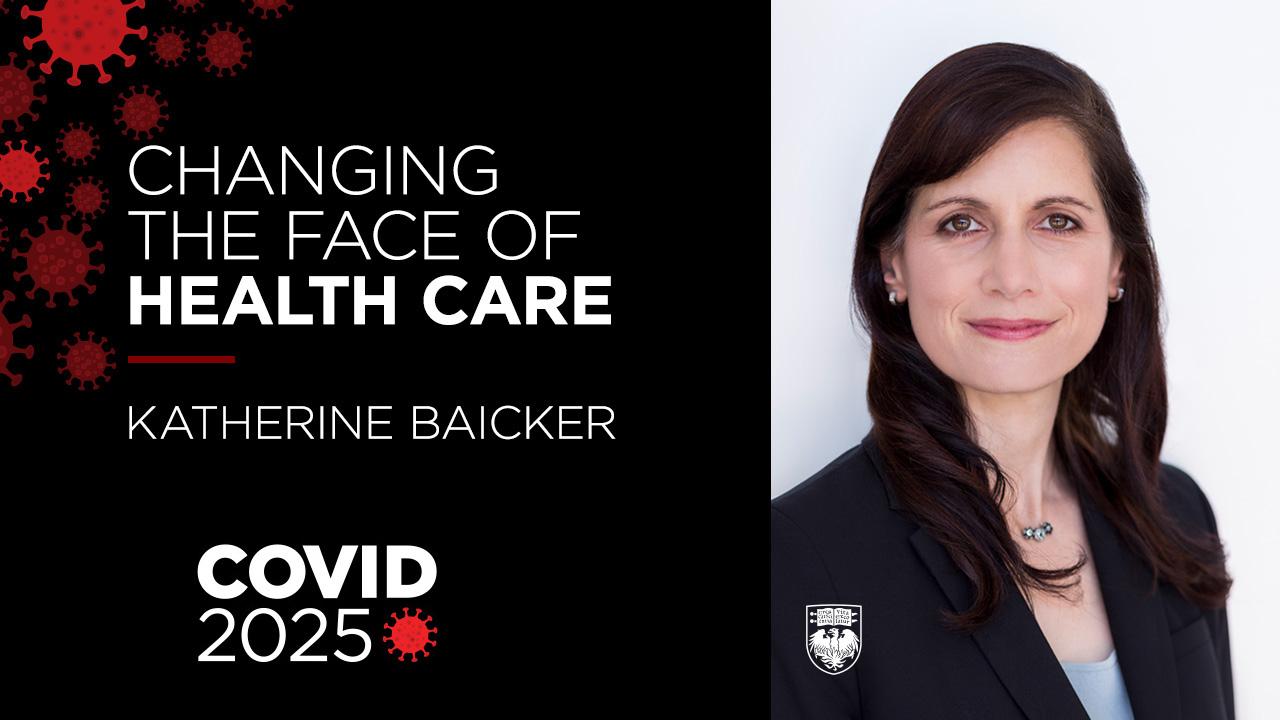The coronavirus pandemic is upending health care in the United States. It could result in a series of changes, ranging from a sizable expansion in telemedicine to a dramatic shift in how we think about health care coverage, says Prof. Katherine Baicker, a leading health economist at the University of Chicago and dean of the Harris School of Public Policy.
In this episode of “COVID 2025: Our World in the Next 5 Years,” Baicker discusses how the pandemic has shown the interconnectedness of the U.S. population—and that old dividing lines between the insured and uninsured no longer make sense. The pandemic could result in support for a more robust public health care system and a variety of new tools to monitor public health, and ramp up or ramp down economic activity if needed.
At the same time, Baicker sees the potential for new measures to increase the flexibility of the U.S. health care system. They could include allowing nurses to work in different states under a single license, letting physician assistants provide expanded care, and removing liability barriers to allow medical equipment makers to increase production at times of crisis.New website explores how UChicago is confronting COVID-19
See the other videos in the COVID 2025 series here. Read more about how UChicago is confronting COVID-19 at this website.
Transcript
KATHERINE BAICKER: Unfortunately, this is probably not the last pandemic that we're going to face. And who knows what we're going to need for the next one.
PRESENTER: The coronavirus is changing life as we know it on a daily basis. In COVID 2025, we'll explore how the pandemic is rewriting our future.
KATHERINE BAICKER: Right now, we have a really blunt policy lever of shutting everything down. The way we've been doing business is not the way that we need. We've seen a little bit of that with businesses being open for vital services or with restaurants opting for delivery instead of dining in.
There are a lot of other industries that may be able to adapt in similar ways so that we can start to resume economic activity safely. That could be alternate days for people to go to the grocery store, depending on their Social Security Number. It could be A-B shifts for different kinds of industries to make sure that there is not so much spread among the whole workforce.
We actually have the data we need now to know which ways of doing business are most likely to spread a disease and how we could modify economic activity so that we can maintain our standards of living while not threatening public health.
Our health insurance coverage is really patchwork right now. That means some people don't have any insurance coverage and some people have insurance that doesn't give them access to the care we need.
First, we need a much more robust public health surveillance system, but we also need a much more coordinated health insurance system.
That means spreading insurance coverage to people who don't already have it, whether that's through public insurance or private insurance.
And then we also need to have a system that rewards innovation and that promotes health care resources being targeted rather than spread across some care of very high benefit and some care of really questionable health value.
Our health care providers have already made heroic efforts to adapt to the pandemic. We could give them even more flexibility.
There could be more flexibility for people to practice at the top of their licenses. That means nurse practitioners can do more, physician assistants can do more, all working appropriately with physicians but letting the workforce be as flexible as it can.
Health care providers could move across state lines to go to parts of the country where their services are most vitally needed. And that would involve some relaxing of state licensure requirements.
We could speed up the regulatory process for approving new tests and new devices so that we could have a more robust population surveillance system in place even faster. We could allow new manufacturers of vital equipment, like ventilators and personal protective equipment, to dial up production without fear of litigation or with knowledge that their products will find purchasers and will be available to people who need them the most.
There is a lot of care that can be delivered remotely. And the old idea of just calling your doctor on the phone and having to describe a symptom, we have much better tools than that. We have video capabilities. We even have remote diagnostics that can be done with equipment people could have in their homes or at local outlets that weren't necessarily attached to a hospital.
I think this crisis is generating a real impetus to use those tools more effectively, to adapt our insurance system to cover them, to adapt our health care infrastructure to use them more consistently. That could let us improve health in a much more effective way going forward, not just in a pandemic but more broadly.
I think before this crisis it was easy to think about the uninsured or the unemployed as those people different from us. But what the crisis has brought to the forefront is the fact that our friends, our neighbors, our family members, our community are all affected by access to health care and by social safety net programs that give them food and resources for rent that they need in times of crisis.
So if we end up with a more robust social safety net and a more robust public health infrastructure, that could be a good thing to come out of a terrible situation.


